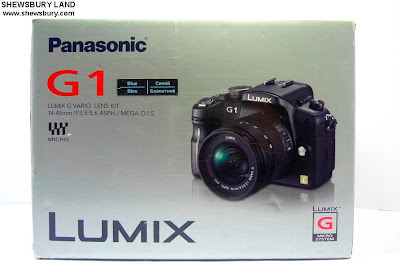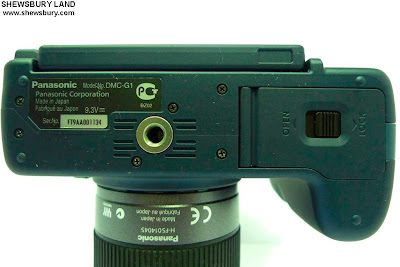Panasonic Lumix DMC-G1

Panasonic G1, yeah, finally... my "dream gadget" since the first time I read about the review 2 years ago in 2009.
Link of the reviews by professional that I read;
Digital Photography Review
Trusted Reviews
Imaging Resource
Finally now in 2011, we managed to grab this camera at reasonable price - considering the fact that this model is no longer in production now though you can eventually get the latest model Panasonic Lumix DMC-G2 which add touch screen feature and of course video (both of which I don't really bother) at the price of almost SGD 1,300.00 locally here plus they have to order it first and you have to wait for at least about 1 week before the item arrived.
This G1, there is 1 small camera shop in town apparently have the (old) stock, so it's cash and carry and you ready to shot.
So let's continue with this amateur review of our dream gadget, Panasonic G1 - I just love the number.
As I mentioned above, this is just an amateur review and thus I cannot provide many important technical information. If you want a more comprehensive review provided by the expert or the pros, go to the links above.
Out of the box (apart from the camera and the lens kit) you will get all these stuff - plus there are some nice thick "user guide book" in the box;

This is now the camera and the lens attached to it already;



This Panasonic G1 can be considered as some sort of DSLR as you can/need to change the lens for different purpose of photography and more spending is possible though eventually they are an evolution of the traditional DSLR system where they can make the body slimmer/smaller by modifying certain elements of the traditional DSLR. Some call it Micro 4/3 System or Mirror-Less System or what ever it is, for me it's just Panasonic G Series... LOL

The above photos taken from Digital Photography Review explaining the mirror-less camera system thingy, a.k.a Micro 4/3 mirror-less system. Note: I do not claim any rights on this photo. This photo were used for information/reference only. All rights and credits belong to the respective copyright owner.
High resolution (460K pixel) wide angle articulated LCD screen - I love!!!!



And the magnificent EVF (as shown below), it's larger than the one you can find on most normal bridge/superzoom digicam, bright electronic viewfinder with 1.4x magnification, 0.7x FF equivalent.

Panasonic use single-panel LED-illuminated Direct-view LCOS (liquid crystal on silicon) technology, and is based on Panasonic's latest professional high-end system video cameras. Certainly one of the most features you will love on this camera as well..... I love!!!!

The above photos taken from Digital Photography Review showing the single-panel LED-illuminated Direct-view LCOS (liquid crystal on silicon) thingy. Note: I do not claim any rights on this photo. This photo were used for information/reference only. All rights and credits belong to the respective copyright owner.
The rear control panel, all those buttons....

On this side is the "Auto Focus" control button though 90% of the time I just use "Auto Focus Single (AFS)" and you can also see the diopter control for the EVF and the flash activation button.

The shooting dial menu for you to choose from full Manual or those Semi Auto and full Auto. You can also see that "Film Mode" button, that is basically for you to choose the color/effect like Standard, Vibrant, Dynamic, BW and so on. The "Quick Menu" button can be customized to do what ever menu or function that you need the most. ;

On this side you can see the compartment for "Remote Control" below it you can see the compartment for HDMI and USB output.

This camera use the cheap SDHC Card, which is a very good news as you can get them anywhere easily and it doesn't cost an arm or leg if you need to buy another one as a spare.

This wheel is for adjusting Aperture and Shutter Speed when shooting in full Manual Mode or in one of those P, A and S Modes. I love!!!!

Made in Japan, maybe that's why this camera is a bit pricey...

That's the battery compartment there;

And this is the battery... I shoot about 500 plus photos using the EVF and/or the LCD alternately depending on the situation with less photo reviewing and finally the battery dry - that is superbly impressive. I love!!!
Currently I only have 2 battery, 1 comes with the camera and the other 1 is a spare, however I will buy another 3 units as extra spare for future use.

The kit lens, Panasonic Lumix G Vario 14-45mm F/3.5-5.6 with 52mm filter threads;

Usually Panasonic "high end" camera comes with lens developed/produced by Leica but I guess over the years they have learned many things from Leica (and possibly also Olympus, their close ally in developing the Micro 4/3 standard) and thus they managed to developed/produced their own lens using their own brand name and nothing else....
This is the lens at "standard" position;

And this is now the lens at full stretch;

Panasonic very own Mega Optical Image Stabilization (Mega O.I.S) system to combat vibration and shake. According to my very own personal experience after been using 4 Panasonic cameras (LZ7, FZ28, LX3 and finally this G1), their "M.O.I.S" technology is indeed quite effective and can be considered as one of the best in the market.

Just for the sake of protecting the front lens glass surface, I use this cheap Kenko 52mm UV Filter.

In addition, I can always use all the 52mm filters that I use for my Panasonic LX3.

Size comparison with our other camera, the DSLR Canon EOS 1000D (Rebel XS);


Our 3 favorite cameras in Shewsbury Land - Panasonic LX3 (10MP), the new comer Panasonic G1 (12MP) and the reliable DSLR for beginners - Canon 1000D (Rebel XS);


OK, finally some photos from this wonderful Panasonic G1 (click the photo for larger view);
The zoom capability of the basic 14-45mm lens kit of this camera (3x optical zoom at full resolution);
At wide angle 14mm (equiv. 28mm)

At full telephoto end 45mm (equiv. 90mm)

This 3X zoom is not great if compared to some bridge/superzoom digicam like Canon SX30 (35x optical zoom) or Fujifilm HS10 and HS20 (30x optical zoom) or Panasonic very own FZ28 and FZ38 (18x zoom) or FZ100 (24x zoom) and not to forget the Panasonic G Vario 45-200mm zoom lens and some other DSLR long zoom lens, however this zoom range is basically enough for "standard and simple" photography purpose. The thumb rule is, if you want more, spend more, simple as that...
Macro and "bokeh" is not bad at all - not great, but I'm happy with it;


Another samples of outdoor scenery photo;





And lastly, quite important, the low light ability of Panasonic G1;
This photo is captured using ISO 1600 in quite a low light situation and I'm very happy with the result.

And again another test, this time I put the Nendoroid Tsukasa underneath my office table;

And now this is the result, this photo is captured using ISO 2500, it may not be able to match other mid-range or high end DSLR camera from Canon/Nikon etc., but for me personally, as an amateur, I think this is good enough - ISO 2500 is something I don't even think about while using Panasonic LX3.


If you interested you can see more photos from the link below, however, all of them were downsized to 1074 x 768 pixels for easy uploading purpose;
Photos from Panasonic G1
I'm not a professional or skilled photographer, I'm happy to just call my self as amateur who love camera and the development of the digital camera world.
Overall, this Panasonic G1 is indeed a very wonderful camera and is set to replaced our Panasonic LX3 as our new main camera and this means the Canon 1000D + Canon EF-50mm F/1.8 Mk. II lens will rest further and will be mainly used for portrait photography.
The "Micro 4/3" image sensor size is about the same to that "4/3" image sensor size used in previous DSLR camera models from Olympus and Panasonic.
As you can see from the picture below, the "Micro 4/3" sensor size is much bigger than the already big (for a compact digicam level) 1.1/6" CCD sensor size used on Panasonic LX3 and eventually Panasonic LX5. I would say that the "Micro 4/3" image sensor size is about 3 or 4 times bigger than those in Panasonic LX3 and Panasonic LX5.
But even so, the "Canon APS-C" image sensor size is still bigger than the "Micro 4/3" image sensor size. This means "in general terms" the traditional DSLR like our Canon 1000D is much better when it comes to low light performance but this also related to the relevant lens factor as well as other technical factor.
So obviously this Panasonic G1 (or rather the G series) is the logical upgrade from a Panasonic LX3/LX5 user point of view though then again, if your pocket permits, you can always aim higher - those high end DSLR models from the big 2 (Canon and Nikon) or even from several other camera maker.

Note: The above image is taken from Wikipedia for information/reference purpose only. All rights and credits belong to the respective copyright owner.
Having said that, I am now still waiting for the following lens (Canon EF-28mm F/2.8) to be used as simple walk around lens with my Canon 1000D but I've been waiting for almost a month now and the local shop where I made my order told me to wait a little while as their supplier is probably running out of stock. I don't mind though as they offered me a decent price and anyway since the Panasonic G1 is available now, I guess I don't mind to wait longer.

And I also considering now either to grab the following Sigma 18-200mm DC OS lens (the local price here is SGD 595.00) or just grab a bridge/superzoom digicam which is also around almost the same range, just slightly higher maybe..... sigh

end


love the camera specially the EVF of this camera.
ReplyDeletealso the wheel where they position on the camera for the shutter speed and Aperture easy are easy to reach when u are using the camera.
well that what i feel lah when i use the camera that time haha
wohoo New awesome Camera in Shewsbury land =)
ReplyDeletelet me check shewsbury photostream for the photos =)
Aya, for your question about image quality after uploaded to Google Blogger, my answer is below;
ReplyDeleteNot really, the photo quality is depend on the actual quality that you upload to Blogger though obviously before we upload, we will reduce the size to certain level that will effect the size (and thus the overall quality as well).
I for example will downsized the photo to 1074 x 768px or 640 x 480px before I upload them. The reason is simply because the internet speed in here is not as great as in Japan/Korea so I don't want to upload a high quality photo with 4MB in size, imagine if you have to upload 30 to 40 photos like I always did, must be pain in the ass to wait for it right?
So if you upload at full 4MB (bigger size) in full high quality, the image that appear in Blogger (after you click for larger view) surely will be great, but the thumbnail size quality will be just decent.
And don't forget, unless if you pay for more storage, the basic free storage space given by the generous big brother Google is only 1GB (1000MB)...
So it's a matter of compromise.